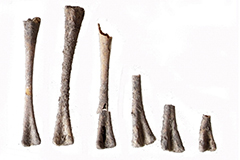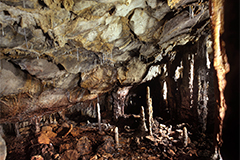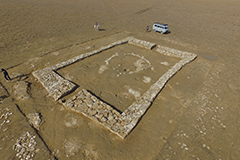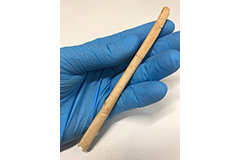World Roundup
March/April 2017


-
 CANADA: A zinc deficiency caused by malnutrition—and not lead poisoning as previously theorized—may have led to the deaths of the Franklin Expedition crew. All 129 men were lost between 1845 and 1848 when their ships became trapped in ice while seeking the Northwest Passage. Recent laboratory analysis of the nails of crewman John Hartnell, who was buried on Beechey Island, indicate that a lack of fresh red meat severely compromised his immune system, making him susceptible to the tuberculosis that eventually killed him. —Jason Urbanus
CANADA: A zinc deficiency caused by malnutrition—and not lead poisoning as previously theorized—may have led to the deaths of the Franklin Expedition crew. All 129 men were lost between 1845 and 1848 when their ships became trapped in ice while seeking the Northwest Passage. Recent laboratory analysis of the nails of crewman John Hartnell, who was buried on Beechey Island, indicate that a lack of fresh red meat severely compromised his immune system, making him susceptible to the tuberculosis that eventually killed him. —Jason Urbanus -
 GREENLAND: It appears that 4,000 years ago the Paleo-Inuit Saqqaq culture may have dined frequently on whale meat. Sedimentary DNA analysis of ancient midden deposits in western Greenland detected surprisingly large proportions of bowhead whale DNA, which was likely left behind by flesh, blood, and blubber remnants seeping into the soil. A scarcity of whale bones at Saqqaq sites and the absence of whale-hunting technology had formerly led scholars to conclude that these mammals were not part of the ancient subsistence economy. —Jason Urbanus
GREENLAND: It appears that 4,000 years ago the Paleo-Inuit Saqqaq culture may have dined frequently on whale meat. Sedimentary DNA analysis of ancient midden deposits in western Greenland detected surprisingly large proportions of bowhead whale DNA, which was likely left behind by flesh, blood, and blubber remnants seeping into the soil. A scarcity of whale bones at Saqqaq sites and the absence of whale-hunting technology had formerly led scholars to conclude that these mammals were not part of the ancient subsistence economy. —Jason Urbanus -
 MEXICO: Today, in parts of southern Mexico, turkeys are a major part of the socioeconomic structure of local communities—just as they were to the culture there 1,500 years ago. At the site of Mitla Fortress in Oaxaca, recently excavated houses contained the earliest and most comprehensive evidence of ancient Zapotec turkey domestication, dating to between A.D. 400 and 600. The abundance of turkey bones and eggshells suggests the birds were raised for food, trade, and use in ritual activities. —Jason Urbanus
MEXICO: Today, in parts of southern Mexico, turkeys are a major part of the socioeconomic structure of local communities—just as they were to the culture there 1,500 years ago. At the site of Mitla Fortress in Oaxaca, recently excavated houses contained the earliest and most comprehensive evidence of ancient Zapotec turkey domestication, dating to between A.D. 400 and 600. The abundance of turkey bones and eggshells suggests the birds were raised for food, trade, and use in ritual activities. —Jason Urbanus -
 BRAZIL: The oldest evidence of humans performing elaborate funerary rituals has been discovered at the cave site of Lapa do Santo in South America. Twenty-six burials, dating back 10,000 years, provide evidence that the bodies were altered before burial: heads were cut off, limbs detached, teeth removed, and flesh scraped from the bone. Despite its seeming brutality, researchers believe this behavior demonstrates a level of cultural complexity and sophistication previously unknown for this time. —Jason Urbanus
BRAZIL: The oldest evidence of humans performing elaborate funerary rituals has been discovered at the cave site of Lapa do Santo in South America. Twenty-six burials, dating back 10,000 years, provide evidence that the bodies were altered before burial: heads were cut off, limbs detached, teeth removed, and flesh scraped from the bone. Despite its seeming brutality, researchers believe this behavior demonstrates a level of cultural complexity and sophistication previously unknown for this time. —Jason Urbanus -
 GERMANY: Ceramic vessels in an Iron Age burial mound near the Heuneburg hillfort held unusual contents. An examination of microscopic protein residues on potsherds reveals traces of Crimean-Congo hemorrhagic fever, a tick-borne disease not endemic to the region, as well as the presence of human tissue. The interred individual likely caught, and died from, the disease outside Germany, and in order to preserve the body for transportation home, the organs were removed and shipped back with the corpse in several jars. —Jason Urbanus
GERMANY: Ceramic vessels in an Iron Age burial mound near the Heuneburg hillfort held unusual contents. An examination of microscopic protein residues on potsherds reveals traces of Crimean-Congo hemorrhagic fever, a tick-borne disease not endemic to the region, as well as the presence of human tissue. The interred individual likely caught, and died from, the disease outside Germany, and in order to preserve the body for transportation home, the organs were removed and shipped back with the corpse in several jars. —Jason Urbanus -
 SPAIN: Proof that Paleolithic humans systematically hunted the Eurasian cave lion may have been found deep within the La Garma cave site in northern Spain. Nine lion phalanx bones, located in the paws, that were uncovered there have been shown to be the remains of a pelt that was spread across the cave floor 16,000 years ago. The precise cut marks on the bones show that humans were adept at removing an animal’s skin while keeping the claws attached, implying that this was a common activity. —Jason Urbanus
SPAIN: Proof that Paleolithic humans systematically hunted the Eurasian cave lion may have been found deep within the La Garma cave site in northern Spain. Nine lion phalanx bones, located in the paws, that were uncovered there have been shown to be the remains of a pelt that was spread across the cave floor 16,000 years ago. The precise cut marks on the bones show that humans were adept at removing an animal’s skin while keeping the claws attached, implying that this was a common activity. —Jason Urbanus -
 TANZANIA: Nearly 1,200 years of the environmental history of the Eastern Arc Mountains have recently been revealed in a core sample taken from a peat bog. Pollen, charcoal, and other organic materials trapped in the sediments show how both human presence and climate change affected the region’s ecosystem over the past millennium. Most significant was the establishment of the ivory trade in the 19th century, which led to both the introduction of foreign plant species and large-scale deforestation. —Jason Urbanus
TANZANIA: Nearly 1,200 years of the environmental history of the Eastern Arc Mountains have recently been revealed in a core sample taken from a peat bog. Pollen, charcoal, and other organic materials trapped in the sediments show how both human presence and climate change affected the region’s ecosystem over the past millennium. Most significant was the establishment of the ivory trade in the 19th century, which led to both the introduction of foreign plant species and large-scale deforestation. —Jason Urbanus -
 KAZAKHSTAN: An amateur metal detectorist who found pieces of decorated silver near the eastern shore of the Caspian Sea led authorities to a previously unknown complex of massive ancient stone enclosures. The silver plating, adorned with animal motifs, was once attached to a wooden saddle that was ritually buried in the 5th or 6th century A.D. Archaeologists are still unsure who built the cultic or funerary complex but believe it was linked to the movement of nomadic tribes or Huns through the area. —Jason Urbanus
KAZAKHSTAN: An amateur metal detectorist who found pieces of decorated silver near the eastern shore of the Caspian Sea led authorities to a previously unknown complex of massive ancient stone enclosures. The silver plating, adorned with animal motifs, was once attached to a wooden saddle that was ritually buried in the 5th or 6th century A.D. Archaeologists are still unsure who built the cultic or funerary complex but believe it was linked to the movement of nomadic tribes or Huns through the area. —Jason Urbanus -
 INDIA: The theory that domesticated rice was originally introduced from China to the ancient Indus civilization is being challenged. Fieldwork at several sites in northwest India seems to confirm that Indus Valley communities did not rely solely on wild rice, but instead developed their own domesticated rice agriculture around 4,000 years ago. This process occurred independently from rice domestication in China and at least 400 years before the appearance of Chinese rice in the region. —Jason Urbanus
INDIA: The theory that domesticated rice was originally introduced from China to the ancient Indus civilization is being challenged. Fieldwork at several sites in northwest India seems to confirm that Indus Valley communities did not rely solely on wild rice, but instead developed their own domesticated rice agriculture around 4,000 years ago. This process occurred independently from rice domestication in China and at least 400 years before the appearance of Chinese rice in the region. —Jason Urbanus -
 AUSTRALIA: A 46,000-year-old kangaroo fibula from a cave in northwestern Australia may be the oldest piece of jewelry ever discovered on the continent and appears nearly 25,000 years earlier than when ancient Australians are thought to have first developed bone-shaping technology. Although it may have been used as an awl, it was more likely a personal adornment worn through the nasal septum. Researchers suspect the tip was broken off during use, perhaps when too much force was exerted during the piercing. —Jason Urbanus
AUSTRALIA: A 46,000-year-old kangaroo fibula from a cave in northwestern Australia may be the oldest piece of jewelry ever discovered on the continent and appears nearly 25,000 years earlier than when ancient Australians are thought to have first developed bone-shaping technology. Although it may have been used as an awl, it was more likely a personal adornment worn through the nasal septum. Researchers suspect the tip was broken off during use, perhaps when too much force was exerted during the piercing. —Jason Urbanus
Advertisement
IN THIS ISSUE
Features
The First American Revolution
Kings of Cooperation
The Road Almost Taken
Letter from Philadelphia
From the Trenches
Digging up Digital Music
Off the Grid
Revisiting Montezuma Castle
Secret Spaces
Something New for Sutton Hoo
A Surprise City in Thessaly
Zinc Zone
Behind the Curtain
Royal Gams
A Mix of Faiths
Neolithic FaceTime
Bathing, Ancient Roman Style
The Church that Transformed Norway
Siberian William Tell
A Traditional Neanderthal Home
Artifact
Self-expression in the Bronze Age
Advertisement

Recent Issues
-
 May/June 2024
May/June 2024
-
 March/April 2024
March/April 2024
-
 January/February 2024
January/February 2024
-
 November/December 2023
November/December 2023
-
 September/October 2023
September/October 2023
-
 July/August 2023
July/August 2023
-
 May/June 2023
May/June 2023
-
 March/April 2023
March/April 2023
-
 January/February 2023
January/February 2023
-
 November/December 2022
November/December 2022
-
 September/October 2022
September/October 2022
-
 July/August 2022
July/August 2022
-
 May/June 2022
May/June 2022
-
 March/April 2022
March/April 2022
-
 January/February 2022
January/February 2022
-
 November/December 2021
November/December 2021
-
 September/October 2021
September/October 2021
-
 July/August 2021
July/August 2021
-
 May/June 2021
May/June 2021
-
 March/April 2021
March/April 2021
-
 January/February 2021
January/February 2021
-
 November/December 2020
November/December 2020
-
 September/October 2020
September/October 2020
-
 July/August 2020
July/August 2020
-
 May/June 2020
May/June 2020
-
 March/April 2020
March/April 2020
-
 January/February 2020
January/February 2020
-
 November/December 2019
November/December 2019
-
 September/October 2019
September/October 2019
-
 July/August 2019
July/August 2019
-
 May/June 2019
May/June 2019
-
 March/April 2019
March/April 2019
-
 January/February 2019
January/February 2019
-
 November/December 2018
November/December 2018
-
 September/October 2018
September/October 2018
-
 July/August 2018
July/August 2018
-
 May/June 2018
May/June 2018
-
 March/April 2018
March/April 2018
-
 January/February 2018
January/February 2018
-
 November/December 2017
November/December 2017
-
 September/October 2017
September/October 2017
-
 July/August 2017
July/August 2017
-
 May/June 2017
May/June 2017
-
 March/April 2017
March/April 2017
-
 January/February 2017
January/February 2017
-
 November/December 2016
November/December 2016
-
 September/October 2016
September/October 2016
-
 July/August 2016
July/August 2016
-
 May/June 2016
May/June 2016
-
 March/April 2016
March/April 2016
-
 January/February 2016
January/February 2016
-
 November/December 2015
November/December 2015
-
 September/October 2015
September/October 2015
-
 July/August 2015
July/August 2015
-
 May/June 2015
May/June 2015
-
 March/April 2015
March/April 2015
-
 January/February 2015
January/February 2015
-
 November/December 2014
November/December 2014
-
 September/October 2014
September/October 2014
-
 July/August 2014
July/August 2014
-
 May/June 2014
May/June 2014
-
 March/April 2014
March/April 2014
-
 January/February 2014
January/February 2014
-
 November/December 2013
November/December 2013
-
 September/October 2013
September/October 2013
-
 July/August 2013
July/August 2013
-
 May/June 2013
May/June 2013
-
 March/April 2013
March/April 2013
-
 January/February 2013
January/February 2013
-
 November/December 2012
November/December 2012
-
 Sep/Oct 2012
Sep/Oct 2012
-
 September/October 2012
September/October 2012
-
 July/August 2012
July/August 2012
-
 May/June 2012
May/June 2012
-
 March/April 2012
March/April 2012
-
 January/February 2012
January/February 2012
-
 November/December 2011
November/December 2011
-
 September/October 2011
September/October 2011
-
 July/August 2011
July/August 2011
-
 May/June 2011
May/June 2011
-
 March/April 2011
March/April 2011
-
 January/February 2011
January/February 2011
Advertisement






